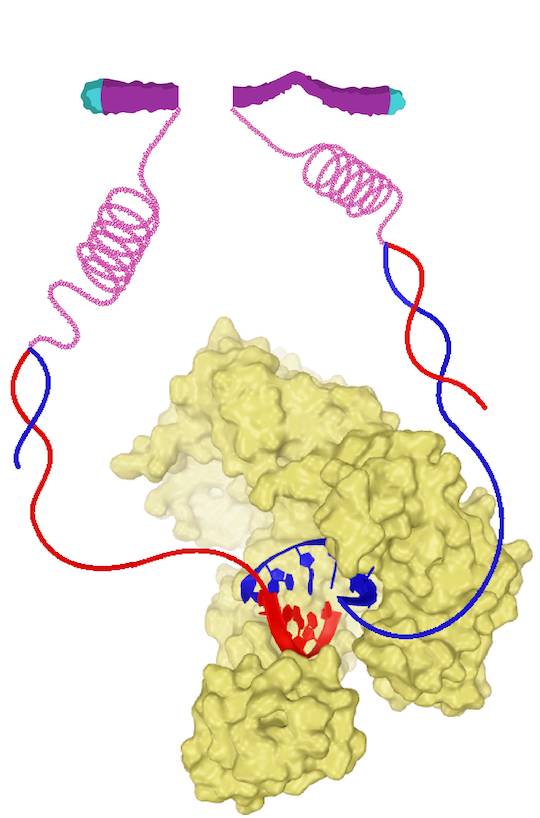DNA polymerase θ is an enzyme that plays a crucial role in the process of repairing broken strands of DNA. In a recent study, researchers at Rice University and St. Jude Children’s Research Hospital in Memphis, Tennessee, analyzed the structure of this enzyme in order to understand its function better and how it might be targeted for precision cancer therapy. The researchers discovered details about the enzyme’s structure that could be helpful in the development of new treatments for cancer.
DNA polymerase theta, also known as Pol theta, is an enzyme that repairs double-strand breaks in DNA by connecting the hanging single-stranded ends and facilitating DNA synthesis across the break through a process called microhomology-mediated end joining (MMEJ). This process is similar to patching a tire.
MMEJ is a process that repairs DNA double-strand breaks and is similar to two other processes called homologous recombination and non-homologous end joining. However, MMEJ is less accurate than these other processes because the enzyme involved, Pol theta, is prone to causing mutations, insertions, and deletions during the repair process.
Present like a Pro! ExpertSlides – The secret weapon for your presentations!
MMEJ relies on the enzyme Pol theta to repair double-stranded DNA breaks. This dependency could be advantageous in the development of cancer treatments targeting Pol theta.
A study published in the journal Nucleic Acids Research has provided insight into the structural basis of how the enzyme Pol theta mediates the repair process known as MMEJ (microhomology-mediated end joining). This is the first time that the structural details of this process have been revealed. The study showed that the unique insertion loops of Pol theta help stabilize short DNA binding as the enzyme prepares the site for MMEJ repair.
DNA double-strand breaks (DSBs) are the most damaging type of DNA damage. If not repaired correctly, a single DSB can lead to genome rearrangement and cell death, which is particularly dangerous for cancer cells as they do not want to die.
A common situation is when patients have a mutation in the BRCA1 or BRCA2 gene. These genes produce proteins that repair DNA, but mutations can cause breast cancer. When there is a problem with these genes, they cannot be repaired using the homologous recombination pathway and must instead utilize alternative repair pathways.
According to the authors, eight years ago, it was discovered that eliminating the Pol theta enzyme in normal cells does not have any adverse effects. However, it can be deadly when this enzyme is eliminated in cells with mutated BRCA1 or BRCA2. This makes Pol theta a potential target for cancer drugs because an inhibitor for this enzyme would only harm cancer cells, not healthy ones.
Other research labs have already begun clinical trials for cancer treatments based on DNA polymerase θ, but the study conducted by the Rice University and St. Jude Children’s Research Hospital labs provides additional insights into the mechanism of the enzyme, which could aid in the development of these treatments.
Final Thoughts
The study on the structural basis of Pol theta mediated DNA end joining provides valuable insights into the function of this enzyme and its potential as a target for precision cancer therapy. The high-resolution structures of Pol theta with different DNA substrates reveal the distinctive structural characteristics of Pol theta that enable it to perform low-fidelity MMEJ synthesis. This information could be useful in identifying potential target sites for drugs and in developing strategies for drug screening and optimization targeting Pol theta.
These findings may have important implications for the development of new treatments for cancer and could potentially lead to improved patient outcomes. Eventually, this research has added to our understanding of DNA repair mechanisms and the role of Pol theta in this process.
Article Source: Paper Reference | Article Reference
Learn More:
Top Bioinformatics Books ↗
Learn more to get deeper insights into the field of bioinformatics.
Top Free Online Bioinformatics Courses ↗
Freely available courses to learn each and every aspect of bioinformatics.
Latest Bioinformatics Breakthroughs ↗
Stay updated with the latest discoveries in the field of bioinformatics.
Dr. Tamanna Anwar is a Scientist and Co-founder of the Centre of Bioinformatics Research and Technology (CBIRT). She is a passionate bioinformatics scientist and a visionary entrepreneur. Dr. Tamanna has worked as a Young Scientist at Jawaharlal Nehru University, New Delhi. She has also worked as a Postdoctoral Fellow at the University of Saskatchewan, Canada. She has several scientific research publications in high-impact research journals. Her latest endeavor is the development of a platform that acts as a one-stop solution for all bioinformatics related information as well as developing a bioinformatics news portal to report cutting-edge bioinformatics breakthroughs.






